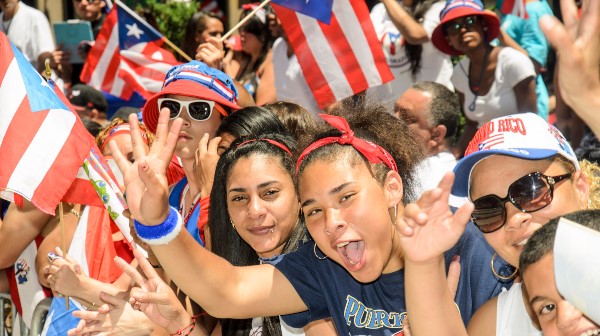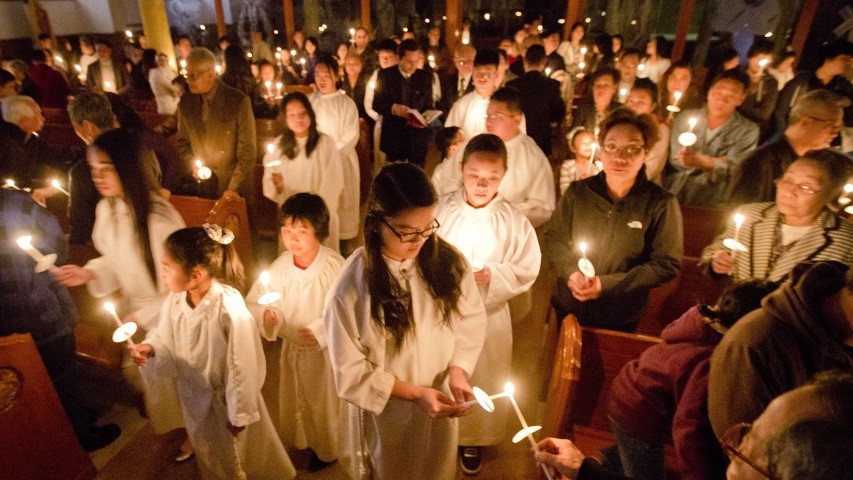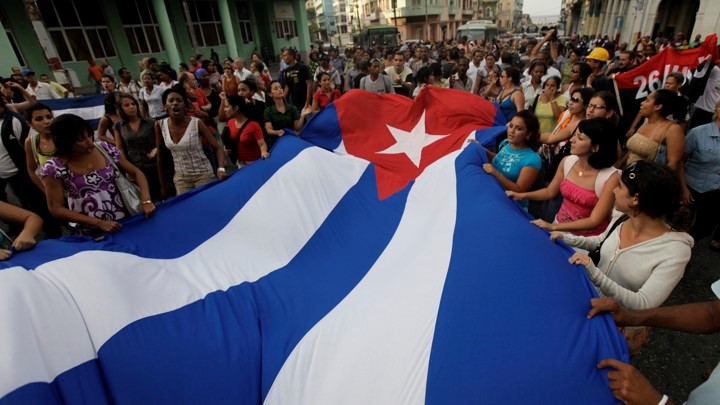Introduction
New Jersey is the fourth most ethnically diverse state (more diverse than New York), and Jersey City is the most ethnically diverse city in the U.S. New York City is Number Three. North Jersey especially is a United Nations of dining; no need to schlep into the big city for ethnic eats, no matter how little known.1
We concluded our reflection on the “pause” or “intermission” between the two great waves of immigration noting that the great Hispanic migration had begun before the change in immigration legislation took place in 1965. This was due to the arrival of many Puerto Ricans, not subject to immigration law, and the sudden flight of Cuban refugees. We will look again at this story, but now within the context of the general Hispanic “wave” of migrants into the archdiocese in the latter part of the 20th century and continuing into the 21st century.
As we focus our reflection on Hispanic Catholics in the Archdiocese of Newark, we should be aware that the percentage of Catholics among Hispanic Americans has been in constant decline over the last several decades. While 70 percent of adult Hispanics in the United States identified as Catholic as recently as 2006, that figure fell to 57 percent by 2015, according to The Center for Applied Research in the Apostolate (CARA), a nonprofit research center. The Pew Research Institute currently estimates the percentage of American Catholic Hispanics at 55 percent. The statistical studies done for the V Encuentro state that only 51 percent of the Hispanics within the Archdiocese of Newark are Catholic.
Pew also has provided estimates of the Catholic population in each Latin American nation. Their studies have shown a precipitate decline in the number of Catholics in these countries. They caution that the number of Catholics appears to drop as they migrate but they have not done an exhaustive study of this phenomenon nor have they produced estimates of the number of Catholics among discrete national groups of Hispanic Americans. Therefore, we safely can estimate that the number of Catholics among any Hispanic national group in the United States is a bit less than the number in their home country.2
Throughout this study, unless otherwise indicated, the figures for particular national groups are those provided by the United States Census Bureau, either the number in the decennial census or the annual estimate. These figures show how individuals, immigrant and native-born, self-identify according to ethnic heritage and ancestry.
Northern New Jersey has been a port of entry for immigrants since the earliest years of the colonization of North America. After independence in 1776, the volume and variety of immigrants increased every year until legislation restricted it in the late 19th century and severely limited it in the early years of the 20th century. Many immigrants to this area were Roman Catholic – from Ireland, Germany, Poland, Italy, and other western, central, and southern European lands. As we saw in our reflection on the first wave of immigration, the Church in New Jersey sought to meet the pastoral needs of each group, and to draw from their talents to enrich the wider church with the variety of their spiritual and cultural contributions.
The volume of immigration often placed a strain on the spiritual and financial resources of the local church. Many new arrivals brought their own priests with them. Some arranged for a priest to come from their country of origin. Integration of newcomers into existing parish structures often was difficult. Misunderstandings often arose from cultural differences. Troubles resulted from conflicts over the use of parish buildings, and feelings were hurt when newcomers were restricted to the use of the “lower church,” the basement. Even with the best intentions, difficulties often occur.
By the late 19th century, the normal policy was to establish separate “national parishes” for each new group. The tight community of the national parish preserved not only the faith but also the language, customs, and culture of the “old country.” The original intention was that the national parish be temporary. Its purpose was to preserve the faith of the newcomers and to aid in their integration into American society. Instead, most national parishes became permanent fixtures. Their schools played an important prole in passing on the faith as well as preserving cultural values while they assisted in the “mainstreaming” of the immigrant population. In the late 20th century, most of these parishes experienced a sharp decline in membership as parishioners moved to the suburbs and out-of-state.
During the late 20th century and early 21st century immigration, the largest group by far were Hispanic. (I have chosen to use the term “Hispanic” rather than “Latino” to name people whose native language is Spanish. I realize that many prefer “Latino.” However, “Hispanic” is the term used by the United States Census Bureau.) The Puerto Rican migration and the Cuban immigration were the first large Spanish-speaking groups to come to the archdiocese after World War II, and they began to arrive before the liberalization of the immigration laws in 1965.
After 1965, Hispanic immigrants came from all of the countries of Latin America and the Caribbean. “The fact that Hispanics come from so many different countries presents a pastoral challenge, because while it is true that they have many common elements, there are many differences and traditions among them.”3
The First Spanish Arrivals
Archdiocesan records note the first clearly discernable Spanish-speaking Catholics in northern New Jersey4 in the 1920s. They came from northern Spain and settled in the port area of Newark and Elizabeth. By 1923, they gathered for Mass in the lower church of Saint Patrick’s Church in Elizabeth.
In 1926, the diocese created Saint Joseph’s Spanish-Portuguese parish in the Ironbound section of Newark. In 1956, a separate Portuguese parish, Our Lady of Fatima, was established. Saint Joseph’s then became a Spanish parish, renamed Immaculate Heart of Mary in 1966. Franciscan Friars of the Third Order Regular from the Spanish island of Mallorca served the parish.
The priests from Saint Joseph’s in Newark also served the Spanish community in Elizabeth at Saint Patrick’s Church. In 1947, Immaculate Heart of Mary Spanish-Portuguese Parish was created in Elizabeth. In 1954, the Religious Teachers Filippini came to the parish where they provided religious education as well as a day care center. In the 1973, the archdiocese created a separate Portuguese parish in Elizabeth, called Our Lady of Fatima. From this time forward, the stories of the Spanish-speaking and Portuguese-speaking migrations diverge, although even today some parishes serve both the Hispanic and the Portuguese communities.
The first phase of Latino migration to some extent followed the pattern established in the 19th century. The immigrants from Spain and Portugal came to a particular section of a city. The diocese established a national parish, served by priests from the “old country.” As it served their pastoral needs, the national parish also preserved much of their cultural heritage as the immigrant entered American society. The national parish, the societies, the local social clubs, all provided an atmosphere of security, stability, and support for the Spanish and Portuguese Americans of the Ironbound and of Elizabeth Port. For the Spanish-speaking, this pastoral pattern would change as mass immigration began.
Puerto Rican Migration
Since the Jones-Shafroth Act of 1917, citizens of Puerto Rico are citizens of the United States without losing their Puerto Rican citizenship. As such, they are free to travel at will within the United States. Because of their citizenship, it is not proper to speak of them as immigrants. Their movement in great numbers from their Caribbean island home to the mainland United States does, however, constitute a significant migration.
After World Wat II, the development of relatively low-cost air travel facilitated the Puerto Rican migration north. The promise of jobs and a better way of life attracted them. The harsh climate in New Jersey made frequent trips “home” desirable and low airfare made them possible. These frequent moves made it difficult for many newcomers to settle into a parish and difficult for the Church to maintain stable contact with them.
The arrival of large numbers of Puerto Ricans in the archdiocese of Newark did not elicit the traditional “national parish” approach to pastoral care. In the past, most European migrants intended to stay in the United States. Puerto Ricans, on the other hand, could travel to and from their home island with relative ease. From the perspective of some church leaders, this mobility made the establishment of national parishes an unsure venture.
Like previous newcomers, the Puerto Ricans were poor; they sought inexpensive housing in aging city centers in Newark, Elizabeth, and Hudson County. Most were not skilled workers and they moved often to find employment and better housing. Frequent moves created difficulties in relating to a specific parish. Many other unskilled immigrants from Latin America moved frequently as well.

Saint Patrick’s Pro-Cathedral
The island of Puerto Rico had very few native clergy. For four centuries, Spanish clergy had served the island. After the United States annexation of Puerto Rico in 1898, North American clergy went to the island and did not cultivate local vocations. The very small number of native Puerto Rican clergy did not have a “surplus” of priests to send to serve in the United States.
Most Puerto Ricans settled in the cities where the parishes were experiencing a decline in numbers due to migration to the suburbs. It did not seem wise to build new facilities when there were sufficient underused churches and other facilities available.
The archdiocese of Newark, for these reasons, received the Puerto Rican migrants into territorial parishes. While convenient and perhaps the only feasible option, it did deprive the Puerto Ricans of a specific sense of ethnic and cultural identity with a parish they could call “their own” within the archdiocese. The dilemma continues whether to serve newcomers through integration into existing structures or through the creation and maintenance of parallel structures.
The City of Newark
The first migrants from Puerto Rico clustered in Newark, Jersey City, and Hoboken. In the early 1950s, they came to the central part of Newark where they found cheap housing and a market for unskilled labor. Saint Patrick’s Pro-Cathedral was the first church to serve Hispanics in the city of Newark. At that time there was a large amount of low rent housing in the area. In 1954, Rev. Genadius Diaz, O.S.B., from Saint Mary’s Abbey (Newark Abbey), began to minister to the needs of the Puerto Ricans attending nearby Saint Patrick’s. The Puerto Rican children soon entered the parochial school. The next year another Spanish Benedictine, Rev. Placidio Alvarez, O.S.B., became the first full-time priest to minister to the Spanish-speaking community.
The pastor of Saint Patrick’s, Msgr. James F. Looney, chancellor of the archdiocese, encouraged the ministry to the Hispanic population. Religious instruction and church services in Spanish became part of the parish program. The 11:00 a.m. Sunday Mass became “La Misa Hispana.” At the time, it was, of course, a Latin Mass with a Spanish homily. The people formed church societies and various church socials drew the community together. The Hispanic ministry at Saint Patrick’s served as a model for many other parishes in this period.
Msgr. Looney assigned Rev. Thomas Heck, assistant pastor of Saint Patrick’s Pro-Cathedral, to assess the needs of the Spanish-speaking of the Archdiocese of Newark. Heck convened the clergy serving the Spanish Apostolate, at first in very informal meetings, at the pro-cathedral. Their discussions revolved around adjusting to different cultural differences, the demographics of the Spanish-speaking population, the social life of the people, and identifying sources of catechetical and devotional materials in Spanish. They urged that the archdiocese prepare more priests for the Spanish Apostolate and devote more of its resources to the needs of the Hispanic population.
Saint Bridget’s Parish in Newark (later merged with Saint Patrick’s Pro-Cathedral) began to serve Hispanics in 1956. The traditional societies were established and La Misa Hispana introduced. The Missionary Servants of the Most Blessed Trinity (Trinitarians) conducted a catechetical program in both Spanish and English. Responding to the poverty of many migrants, the parish also started a food pantry, an employment office, and, later on, an immigration-counselling program. The priests at Saint Bridget’s had no formal training in Spanish and learned “on location.” This informal approach to language study was not uncommon.
Jersey City
In the 1950s, the availability of work in the factories and along the waterfront attracted Puerto Rican migrants to the downtown section of Jersey City. Cheap housing also made this area attractive.
Saint Peter’s Parish, staffed by the Jesuits, was the first to minister to the new arrivals. Rev. Joseph Faulkner, S.J., established an “outreach center” that made social services and religious instruction available in a “store front” location. A similar center was established in Hoboken. These centers served for an interim period before most immigrants gravitated to the parishes.
Archdiocesan Ministerial Initiatives and Formalized Spanish Studies
Ministry in Spanish was essential. People are accustomed to pray in their native language. The language and the culture bind the people to their faith in many ways. Respect for their culture strengthens the faith of the immigrants and their trust in their clergy. It enables them to adjust to their new religious environment.
Since the 1930s, seminarians in the archdiocesan seminary studied a foreign language in the “Master School of Modern Languages.” Students were required to study the language of their parents, or, if their parents spoke English, Italian. In 1954, Spanish became part of the curriculum. Seminarians who studied Spanish would spend part of their summers assigned to parishes with a Spanish-speaking population.
In 1958, the archdiocese assigned Fathers Heck and Feketie to study Spanish in Puerto Rico for a year. Upon their return, they served the Hispanic community for many years. Upon ordination, many of the seminarians who had studied Spanish were assigned to parishes with a Hispanic population.
Catholic Charities and the Mount Carmel Guild offered social services to the Hispanic population. As time went on, these agencies added Spanish-speaking members to their staffs.
A New Pastoral Pattern for mid-20th Century New Immigrants Emerges
The post-World War II wave of Puerto Rican migration set the pattern for the pastoral care of the Spanish-speaking Catholics who followed. The migrants arrived and soon became a recognizable group in the community. The local parish sought to serve them just as parishes served previous immigrant groups. The children entered the parochial school. Eventually the parish offered religious services in Spanish. Societies were soon established and cultural events and festivals held.
In the next decades, the wave of immigration became a flood. Some parishes became mostly Spanish-speaking almost overnight. The archdiocese created new offices and ministries to meet new needs. However, the basic post World War II pattern of parochial absorption of new immigrants remained for Hispanics.
In New Jersey, the Puerto Rican population has grown from 138,896 in 1970 to 479,873 in 2017. Of this number, 182,083, or about 38 percent, live within the archdiocese of Newark. Almost two-thirds of the Puerto Ricans in the archdiocese live in Hudson and Essex counties, with a growing number in Bergen County. There are no clear estimates of the percentage of Puerto Ricans in the United States who are Catholic, but the Pew Institute studies estimate that 56 percent of Puerto Ricans are Catholic.5
Puerto Rican Population of New Jersey 1970 – 20106
| 1970 NJ | 1980 NJ | 1990 NJ | 1970 NJ | 2000 | 2010 NJ | 2010 RCAN* |
|---|---|---|---|---|---|---|
| 138,896 | 243,540 | 304,179 | 138,896 | 366,788 | 434,092 | 163,351 |
*Roman Catholic Archdiocese of Newark
Puerto Rican Population of the Archdiocese of Newark
| Bergen | Essex | Hudson | Union | NJ | RCAN | |
|---|---|---|---|---|---|---|
| 2010 | 25,786 | 54,005 | 56,436 | 27,142 | 434,092 | 163,351 |
| 2017* | 34,806 | 57,452 | 58,364 | 31,461 | 479,873 | 182,083 |
Decennial dates are Official United States Census
*United States Census Bureau Estimate
1959 – The Cuban Exodus
Just as the Archdiocese was beginning to respond to the mostly Puerto Rican Hispanic community in an organized manner, a new wave of immigrants suddenly arrived from Cuba.
A small number of Cubans had been resident in northern Hudson County since the 1940s. Saint Michael’s Monastery Parish in Union City, served by the Passionist Fathers, hosted the first Misa Hispana (Latin Mass with homily in Spanish) in northern Hudson County in August 1955. Fourteen people attended the Mass, celebrated by Rev. Joseph Faulkner, S.J., of Saint Peter’s Parish in Jersey City. The numbers climbed and a Spanish Mass was celebrated every Sunday. Rev. Richard Kugelman, C.P., of the Passionist community, took charge. By 1956, there was a choir and a group of catechists. In 1957, societies were established. The community was mostly Puerto Rican with a small group of Cubans. That same year, the societies purchased a statue of Our Lady of Charity, Patroness of Cuba.
The revolution of Fidel Castro and the subsequent introduction of Communism to Cuba drove numerous Cubans to seek refuge in the United States. Many came to the Newark archdiocese. They gravitated to Union City and Elizabeth. Like most European immigrants, their decision to come was irrevocable. They had lost their jobs and their property in Cuba; many had endured forced labor. Many of the early arrivals hoped that they would be able to return to Cuba. This hope would not be realized for almost fifty years.
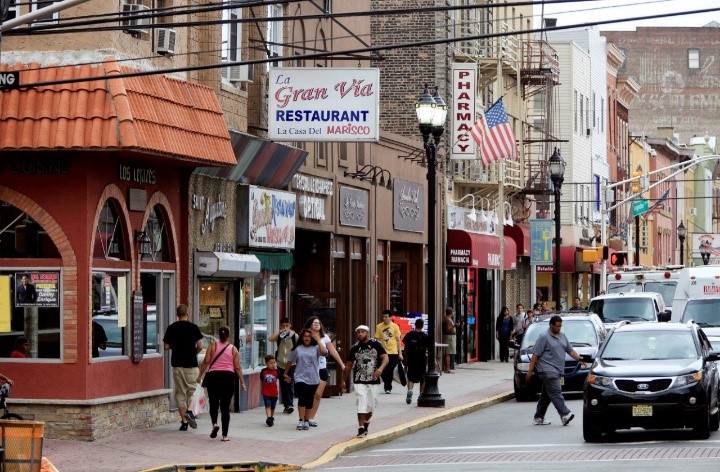
Like previous Hispanic immigrants, they joined the local parishes. Many Cuban immigrants were quite well educated in secular and religious subjects. Some had held leadership positions in their parishes in Cuba. Although confronted with a harsh climate, loss of social status, and the necessity of learning English; they were very interested participating in parish life.
Saint Augustine’s Parish in Union City became a focal point for the Cuban community. A Spanish-speaking priest, Rev. Michael Feketie, had been there since 1959. Along with spiritual and educational assistance, the parish was very active in efforts of resettlement and social services. Other Union City parishes – Saint Anthony’s, Saint Rocco’s, and Holy Family – served an increasing Hispanic population in the 1960s. Puerto Ricans and immigrants from other Latin American nations soon joined the Cubans in Union City.
In West New York, ministry among the Hispanic people began in the late 1960s. The sudden and rapid Cuban immigration expanded the need for Spanish services. Our Lady of Libera and Our Lady Help of Christians parishes also served the expanding Hispanic community.
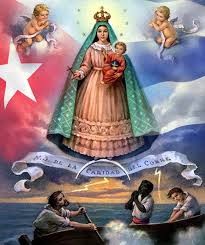
After the Communist takeover of Cuba in 1959, the number of Cubans in New Jersey quickly reached 68,048. Since then, it has increased to about 90,000. Almost two-thirds of Cubans in New Jersey live in the archdiocese of Newark. Almost half live in Hudson County. Pew studies estimate that 51 percent of Cubans in Cuba are Catholic.
In 1980, there was another Cuban immigration, leaving from the port of from Mariel. Some of these Marielitos were relatives of those already here and well established. Some joined their families and entered into the existing Cuban communities. Unfortunately, the Castro government took advantage of the situation to expel some undesirable people and some with mental disorders. The Catholic Church, in general, and the archdiocese of Newark, in particular, took great interest in reuniting families and attempting, through social agencies and local parishes, to help the detached and maladjusted.
Cuban Population in the Archdiocese of Newark
| Bergen | Essex | Hudson | Union | RCAN | |
|---|---|---|---|---|---|
| 2010 | 12,708 | 5,310 | 28,652 | 11,085 | 57,755 |
| 2018* | 13,684 | 6,072 | 26,296 | 13,623 | 59,675 |
Cuban Population in New Jersey 1970 – 2010
| 1970 NJ | 1980 NJ | 1990 NJ | 2000 NJ | 2010 NJ | 2010 RCAN | 2018* NJ | 2018* RCAN |
|---|---|---|---|---|---|---|---|
| 68,048 | 80,860 | 87,085 | 77,337 | 83,362 | 57,755 | 90,000 | 59,675 |
Decennial dates are Official United States Census
*United States Census Bureau Estimate
The next three tables outline the three sites in New Jersey that originally became home to a relatively large number of Cubans during the last fifty years. They are Union City and Hudson County, where the number of Cubans has decreased over time, and Bergen County, where according to the 2010 U.S. Census the number of Cubans has doubled since 1990.7
Cuban Presence in Union City, New Jersey (1990-2010)
| U. S. Census Bureau | 1990 | 2000 | 2010 |
|---|---|---|---|
| Union City Population | 56,088 | 67,088 | 66,455 |
| Hispanic Population | 42,884 | 55,226 | 56,291 |
| Hispanic Population as % of Total Population | 75.8% | 82.3% | 84.7% |
| Cuban Population | 14,709 | 10,296 | 7,510 |
| Cuban Population as % of Total Population | 26.0% | 15.3% | 11.3% |
| Cuban Population as % of Hispanic Population | 34.3% | 18.6% | 13.3% |
Cuban Presence in Hudson County, New Jersey (1990-2010)
| U.S. Census Bureau | 1990 | 2000 | 2010 |
|---|---|---|---|
| Hudson County Population | 553,099 | 608,975 | 634,266 |
| Hispanic Population | 183,465 | 242,123 | 267,853 |
| Hispanic Population as % of Total Population | 33.17% | 39.8% | 42.2% |
| Cuban Population | 44,115 | 33,901 | 28,652 |
| Cuban Population as % of Total Population | 7.98% | 5.56% | 4.5% |
| Cuban Population as % of Hispanic Population | 24.0% | 14.0% | 10.7% |
Cuban Presence in Bergen County New Jersey (1990-2010
| U. S. Census Bureau | 1990 | 2000 | 2010 |
|---|---|---|---|
| Bergen County Population | 825,380 | 884,118 | 905,116 |
| Hispanic Population | 49,776 | 91,377 | 145,281 |
| Hispanic Population as % of Total Population | 6.0% | 10.3% | 16.1% |
| Cuban Population | 6,984 | 9,381 | 12,708 |
| Cuban Population as % of Total Population | 0.85% | 1.06% | 1.4% |
| Cuban Population as % of Hispanic Population | 14.0% | 10.27% | 8.7% |
Growing Hispanic Presence From Many Countries
During the Cuban migration to Hudson County in the 1960s, the growth of other Hispanic communities continued unabated. The Parishes of Saint Mary, Saint Boniface, Saint Bridget, and Saint Michael served the Hispanic population of Jersey City. Saint Mary and Saint Michael Parishes then offered parochial school education at both the elementary and secondary levels. The parishes also provided social services and emergency aid. In Hoboken, poor Hispanics, attracted by jobs in the factories, joined Our Lady of Grace Parish and Saint Joseph Parish, where Spanish-speaking Franciscan Friars were available. In Bayonne, Assumption Parish began to serve the Hispanic community in 1963.
Bergen County
In the 1960s, Central and South American immigrants, many from Colombia, began to settle in southern Bergen County. Saint Francis was the first parish in Hackensack to welcome these newcomers. Saint Cecilia’s in Englewood as well as Holy Trinity in Hackensack also sought to meet the needs of their increasing Hispanic parishioners by offering liturgy and religious education programs in Spanish.
Union County
In Union county, Cuban refugees gravitated to Elizabeth and to Saint Patrick’s Parish, already a Hispanic center. Holy Rosary, Elizabeth, also attracted many Hispanic parishioners.
Newark
While more and more Cubans were moving into North Hudson and Elizabeth, the Puerto Rican population of Newark was growing rapidly. Saint Columba’s, besides the usual parish services, opened a credit union, a thrift shop, an employment service and a residence for men. As population patterns changed, Saint Rocco’s began serving Hispanics who moved into the Central Ward. Saint Ann’s Church, merged with Saint Rocco’s, is the site of the National Shrine of Jesus del Gran Poder. By 1962, fourteen parishes offered religious services in Spanish. That same year, a Spanish mission opened at Saint Michael Parish, staffed by the Vocationist Fathers.
One great resource was the women religious. As teachers in parochial schools, they were, in many cases, the first to meet the newcomers. The early years were difficult in many parishes with growing Hispanic populations. Parish finances dwindled as the poor became more prominent in the pews. Cultural and language barriers had to be overcome. At the same time, many women were leaving religious life.
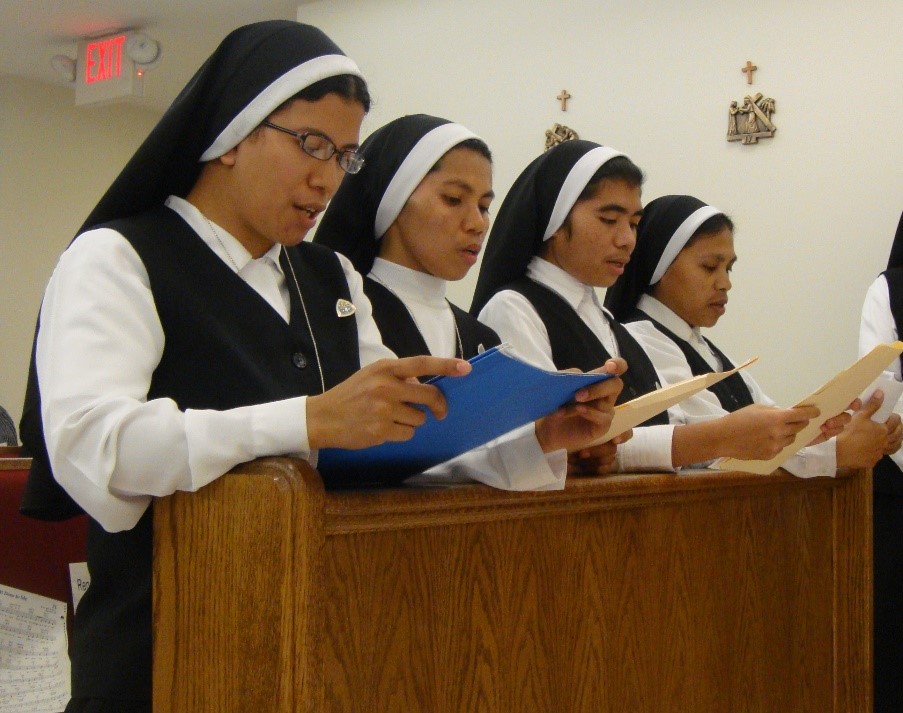
In spite of difficulties, many religious women remained to serve the Hispanics of the cities. Sisters of Charity and Dominican Sisters continued to serve in many newly Hispanic parishes. The Missionary Sisters of the Blessed Sacrament and Mary Immaculate, the Missionary Servants of the Most Blessed Trinity, the Daughters of Saint Paul, the Augustinian Recollect Nuns, the Missionary Sisters of Our Lady of Mercy, the Servants of Saint Joseph, and the Vocationist Sisters focused on Hispanic ministry. The record of service given to the Hispanic community by these women religious cannot adequately be recorded, except perhaps in the hearts of the people to whom they had ministered.
Equally active have been the male religious orders. Some, Jesuits and Passionists, were already staffing parishes when the Hispanic migration began and welcomed the newcomers. Others, Vocationists, Augustinian Recollects, and Scalabrini Fathers have come to the archdiocese of Newark for this specific apostolate.
In the 1960s, many Newark archdiocesan clergy learned Spanish and a number of Latin American diocesan clergy began to serve in the archdiocese. By the end of that decade, it was clear that the Hispanic population had increased to such a degree that further archdiocesan organization and coordination was necessary. In 1970, Archbishop Boland named Fr. Thomas Heck the first Vicar for Hispanics. A centrally organized Hispanic Apostolate was now in place at the Archdiocesan level.
Popular Lay Religious Movements
Cursillo
Even without central coordination, various popular religious movements took root. The Cursillos de Christianidad began in Spain and came to the Archdiocese through the Augustinian Recollects of Tagaste Monastery in Suffern, New York. The first Cursillo was held at Tagaste in September 1961. A year later, Rev. Thomas W. Heck brought the Cursillo to the Archdiocese of Newark. The Cursillo Movement has raised the awareness of the laity of their role in the Church, formed and provided lay leadership, and reached out to the alienated.
Legion of Mary
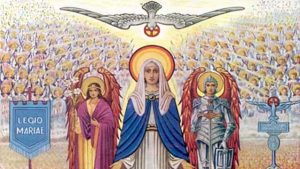 From the early 1960s, some parishes with Hispanic congregations had Praesidia of the Legion of Mary. They had been members in their country of origin. The members are involved in home visitations, attention to the sick and religious education. There are Hispanic Curias in Hudson, Essex, and Union counties.
From the early 1960s, some parishes with Hispanic congregations had Praesidia of the Legion of Mary. They had been members in their country of origin. The members are involved in home visitations, attention to the sick and religious education. There are Hispanic Curias in Hudson, Essex, and Union counties.
Marriage Encounter
 In 1968, a team of 18 priests and 40 married couples travelled from Spain to bring the Marriage Encounter Program to the Archdiocese. The team stayed at Saint Patrick’s Pro-Cathedral during the visit. Their work was so fruitful that by 1969 many Hispanic parishioners participated in Marriage Encounter and organized units of the Christian Family Movement in their parishes.
In 1968, a team of 18 priests and 40 married couples travelled from Spain to bring the Marriage Encounter Program to the Archdiocese. The team stayed at Saint Patrick’s Pro-Cathedral during the visit. Their work was so fruitful that by 1969 many Hispanic parishioners participated in Marriage Encounter and organized units of the Christian Family Movement in their parishes.
Charismatic Renewal
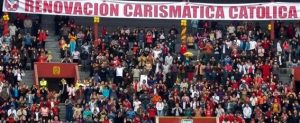 The charismatic prayer experience came about quite spontaneously in the Hispanic community of the archdiocese. For many Hispanics there is a natural attraction to charismatic prayer. The emotional style of prayer, the very expressive and lively music, and the small group atmosphere are aspects that fit very well with many Hispanic cultures.
The charismatic prayer experience came about quite spontaneously in the Hispanic community of the archdiocese. For many Hispanics there is a natural attraction to charismatic prayer. The emotional style of prayer, the very expressive and lively music, and the small group atmosphere are aspects that fit very well with many Hispanic cultures.
Social Change
Following the example of all immigrants, as Hispanics became more numerous and more established, they sought better housing. Quite often, they settled in nearby municipalities. This dispersal can cause pastoral challenges. The diversity of the community also makes organization more difficult. While there is a common language and culture, there is great diversity of Church experience and personal piety among Hispanics from different countries.
In some of the larger Hispanic communities in other cities, one group, usually Puerto Ricans or Cubans, came first and Hispanics from Central or South America, as well as the Caribbean, tended to adapt to the larger numerical group as they arrived. As a new group arrives and grows, it may or may not establish itself as separate from other Hispanics. Within a city, the first parish to serve the Hispanics sets the pattern that is repeated as the population increases and spreads. In time, the community develops leadership, and as more services are available, the Hispanic population becomes a part of the parish, sometimes the majority of the parish.
Some movement takes place by personal choice, to leave the poorer neighborhood or to obtain better housing. Today, a process known as gentrification is causing a mass exodus of Hispanics from Hoboken and downtown Jersey City. These areas have become desirable for their historic houses and proximity to New York City. There were incentives given to developers and to individuals to convert the neighborhoods from “undesirable locations with sub-standard housing” to “luxury historic neighborhoods.” Many ordinary city homes, often owned by Hispanics, escalated in value to unbelievable amounts in a very short time. An unfortunate side effect of this inflation in the value of urban real estate was the displacement of those who were renting. The process is continuing, especially throughout Hudson County.
South and Central Americans
The account of the Hispanic presence in the four counties of the archdiocese, after the initial Spanish immigration, has emphasized Puerto Ricans or Cubans, although there have been some exceptions. This is because they were the first to arrive in certain areas, and because they came here with the legal status of citizens or refugees. South and Central Americans, as well as Dominicans, came later. They tended to gravitate toward the existing Puerto Rican and Cuban parishes and communities. Because many of them were undocumented, their status was insecure. They seek the sacraments and attend Mass, but, out of fear of deportation, they often keep a very low profile and shy away from involvement in parish life. Many work several jobs or long, unusual hours. It is not unusual for them to be mistreated by employers.
Before 1990, the only categories in the United States Census report for Hispanics were Mexican, Puerto Rican, Cuban, and Dominican. In the 1990 census, separate categories appeared for other Hispanic nations.
Pastoral Actions
The archdiocese of Newark has been of great service in providing immigrant counselling and, where possible and when requested, facilitating attainment of legal status. The parochial schools have also been a haven when local school districts began asking questions about legal status. For more than a century, parochial schools were a major force for passing on the faith within the immigrant communities. The decline in the number of parochial schools, together with their increasing cost, weakens evangelization efforts among recent immigrant groups and calls for new pastoral initiatives and strengthened religious education programs.
Since the undocumented immigrants live in constant fear of deportation, the local parish priest is sometimes the only one trusted. Rev. William Reilly, at Saint Bridget’s Parish in Newark, recognized their special needs. Many undocumented aliens were paying high fees to lawyers without, necessarily, obtaining the desired results of legal alien status. With a grant of $6,400 from the Campaign for Human Development, Father Reilly began an immigration counselling service in 1976. It was called Immigration Assistance Service.
In 1976, Catholic Community Services (Catholic Charities) opened a migration office to assist undocumented immigrants. Catholic Charities continues to offer this assistance today.
Priests, Permanent Deacons, and Pastoral Care
Most American priests of Euro-American background were not culturally equipped to understand the religious culture of the many different Hispanic nationalities.
The pastoral care of the Hispanic immigrant population in the archdiocese of Newark covers the gamut of pastoral responses to immigration. Initially, the diocese established a joint national parish with the Portuguese for the Spanish. After World War II, a number of Newark priests learned Spanish to minister to their new parishioners, the Puerto Rican migrants. The archdiocese also encouraged seminarians to learn Spanish to prepare for this ministry.
Gradually a few priests came from Latin America as adjuncts. In the mid-1970s, the archdiocese initiated a clear canonical process whereby priests could be incardinated into the diocese after consultation with their bishops or religious superiors. A number of priests, both religious and diocesan, from Spanish-speaking countries, took advantage of the opportunity. They now are an integral part of the diocesan clergy of the archdiocese. They mainly serve in parishes with a significant Spanish-speaking population. As in the past, religious clergy, such as the Vocationists, served immigrants. The newcomers mostly integrated into urban parishes and established autonomous communities and, in many cases, became the majority group of the parish.
In the 1980s and 1990s, Immaculate Conception Seminary trained seminarians to improve their Spanish-language skills to serve the increasing Latino populations of the sending dioceses and the archdiocese of Newark itself. For several years during the 1990s, the seminary, in a collaborative program with Seton Hall University, sent seminarians for summer studies in Spanish language and Latino culture to the Universidad APEC in Santo Domingo in the Dominican Republic. In the 1980s, the seminary had a Hispanic pastoral program that included a course in pastoral Spanish, a mini-course in Latin American history, visits to the Hispanic community, and a monthly Mass in Spanish.
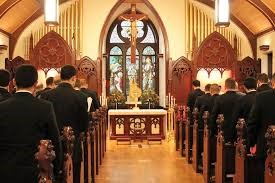
School of Theology
Seton Hall University
Beginning in the 1990s, language studies in the seminary also had an English component. In 1991, one out of four of the 33 incoming seminarians claimed a language other than English as his native tongue.8 The next year, as the number of students needing English-language assistance approached 30 percent; the seminary moved all ESL students into Seton Hall University’s program9 and created special ESL classes to meet the specific needs of seminarians. In the 1990s, the Gerety Lectures provided lectures on Asian-American, African-American, and Hispanic Catholicism.10 By the 1993–94 academic year, 49 of the seminary’s 182 lay and clerical students were foreign-born. The percentage was higher among seminarians.11
In the 1990s and 2000s, the archdiocese actively recruited seminarians from Latin America. Gradually the resident Hispanic community has provided candidates for the diocesan priesthood. This has been the history and tradition of immigrant peoples. Immigrant, second, and third generation Hispanics have pursued priestly vocations. Sons of immigrant parents become priests to serve the needs of their own community, and eventually succeeded those priests who came as immigrants. As the years passed, Hispanic deacons and lay women and men moved into areas of greater responsibility for pastoral care at the diocesan level.
A very important part of pastoral ministry within the Hispanic community has been entrusted to permanent deacons. The diaconate program, from the very beginning, has welcomed and ordained Hispanic candidates. In many instances, they have become the main Spanish-speaking clergy of their parishes. Apart from regular opportunity for preaching, the Hispanic deacons often preach when the priest, presider of the liturgy, is not fluent in Spanish. They also provide pre-baptismal instruction, celebrate Baptisms and marriages, and conduct wake services. A significant number of permanent deacons, including Hispanic deacons, serve in pastoral and administrative leadership positions in the Archdiocese.
The Neo-Catechumenal Way

In 1993, at the invitation of the archbishop of Newark, the Neo-Catechumenal Way opened Redemptoris Mater Archdiocesan Mission Seminary in Kearny. The Neo-Catechumenal Way has had a significant impact on pastoral care and evangelization in the archdiocese, particularly among the Hispanic community. Founded in Spain, its spirituality is familiar to many Hispanics. Many of its priests, all of whom are incardinated priests of the archdiocese of Newark, are from Spain or Latin America and speak Spanish fluently. There also is a significant number of Portuguese-speaking Neo-Catechumenate priests from Portugal and Brazil. This makes them ideal ministers to the Hispanic and Portuguese, and Brazilian communities. Over the years, large numbers of Spanish- and Portuguese-speaking Catholics have joined the parish communities of the Neo-Catechumenal Way or have been under the pastoral and evangelizing care of priests of the Neo-Catechumenate.
An example is Saint Mary’s Parish in Plainfield. It competes with Saint Joseph of the Palisades in West New York to be the largest parish in the archdiocese. In Plainfield, almost 4,500 parishioners attend Mass each Sunday. Priests of the Neo-Catechumenate serve the parish and many parishioners are members. Saint Columba’s Parish in Newark was on the brink of closing when it was assigned to priests of the Neo-Catechumenal Way and now is a viable, largely Hispanic parish.
Today, Newark priests who are members of the Neo-Catechumenal Way number more than 100. A significant number serve in predominately Hispanic parishes or in parishes that have a sizeable Spanish-speaking population.
Popular Religiosity and Celebrations
As the number of Hispanics grew, the public manifestations of religious celebrations gained acceptance and recognition within the archdiocese of Newark. These celebrations are a source of pride and unity for the different national groups of Hispanics. Mainly celebrations of the Blessed Virgin Mary under various titles prominent in the nations of Latin America, they demonstrate the depth of devotion of the Hispanic peoples to the Mother of God.
These feasts and observances usually originated within a small local community with the assistance of the local clergy. While each Latino group had its own specific religious cultural characteristics, there were many similarities. Many came from rural areas that, for centuries, only saw a priest several times a year.
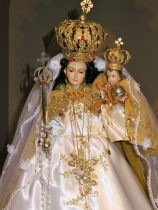
Quickly, parishes added shrines to these many Madonnas. Saint Patrick’s Pro-Cathedral installed a statue of Our Lady of Providence, donated by the Puerto Rican community, the first Latino group in the parish, in 1985. Similarly, in 2001, a shrine was dedicated to Our Lady of Quinche, patroness of Ecuador, donated by Saint Patrick’s most recently arrived group, the Ecuadorians. In some parishes, such as Saint Mary in Jersey City, we can find more than a dozen statues of the Blessed Virgin, each one precious to a different national group.
The lack of proper documentation of many Hispanics parishioners has created pastoral challenges over the last few decades. It is difficult to know the exact number of Catholic faithful. The undocumented hesitate to register out of the mistaken fear that the police and ICE might obtain their addresses and other personal information from the parish. This fear also leads to frequent moving from place to place, out of fear of discovery. The same fear leads many to neglect to solemnize their marriages in the church, or in civil venues, for that matter. Similarly, they fear to register for sacraments for their children out of the same concern and from lack of familiarity with the many sacramental regulations and programs in the United States, so different from their home country. This is a constant cause of confusion and misunderstanding.
While the Puerto Rican and Cuban immigrants drew the most attention initially, as years passed, immigrants from every nation in Central and South America came into New Jersey and into the archdiocese, together with thousands from Africa, Asia, and the Pacific Islands.
«III. The “New” People of Newark A New World – A Microcosm of the Universal Church« : »V. The Second Wave and The Great Hispanic Migration and Immigration Part Two»
Footnotes
- https://www.nj.com/entertainment/index.ssf/2018/12/the_50_best_reasons_to_live_in_new_jersey.html
- Pew Research Center. “Religion in Latin America: Widespread Change in a Historically Catholic Region” (PDF). November 2014. Retrieved 22 October 2018.
- Asterio Velasco. Una Huella Profunda – Pinceladas historicas de la Parrochia de San José y San Miguel Union City, New Jersey (1851-1997). New Jersey, 45.
- Presencia Nueva: Knowledge for Service and Hope: A Study of Hispanics in the Archdiocese of Newark. Office of Research and Planning, Archdiocese of Newark, 1988. A portion of this essay is taken from or adapted from the historical study of Spanish-speaking ministry that I wrote for inclusion in Presencia Nueva.
- Pew Research Center.
- United States Census, 2010.
- Roger E. Hernandez. Cuban Immigration. Broomhall PA, 12-26 passim.
- Harahan to Scholz, November 30, 1990, in AICS 2.3.1.
- Harahan to Scholz, February 24, 1992, in AICS 2.3.1.
- Seminary Committee Minutes, October 15, 1991, in AICS 2.3.1.
- Self–Study 1993–94, in AICS 2.3.1.



